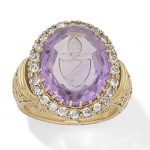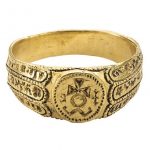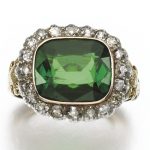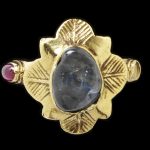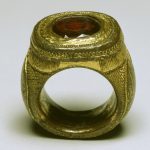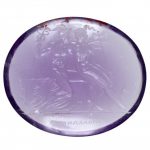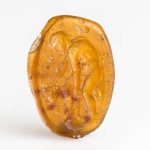Information and history of Episcopal rings. Episcopal rings are issued by the Vatican and are usually engraved gold rings that will be returned upon the death or retirement of the Cardinal. Once appointed a Cardinal will usually commission a gem set ring. The favoured stones used in Ecclesiastical rings were sapphire, amethyst, ruby and tourmaline. Such rings are sometimes gifted by the diocese, remaining the property of the trust. In some cases the ring may be interred with the Cardinal upon his death. The large size is so they can be worn over a glove during full ceremonial regalia, sometimes with an additional band to enable them to be worn without a glove. Reference: Sotheby’s
Below are some examples of Episcopal rings throughout the ages.
A 19th century amethyst and diamond Episcopal ring The oval-cut amethyst intaglio seal, within a surround of old brilliant-cut diamonds, between tapered shoulders, each decorated with budded crosses, the inner hoop engraved ‘Presb. 1855. 13th. 1899. Thomas Bunbury D.D’, diamonds approx. 0.70ct total, ring size W FOOTNOTES Thomas Bunbury D.D., (1829-1907) was educated at Trinity College, Dublin and ordained in 1854. He married Mary Thomasina Simpson on 13th September 1855 and became Bishop of Limerick, Ardfert and Aghadoe in 1899, a position he held until his death.
Sold for £4,750 inc. premium at Bonhams in 2017
Medieval Episcopal Ring “Joye Sans Fyn” Date:15th century Culture:British Medium:Gold
Reference: The Metropolitan Museum of Art
Tourmaline and diamond “Episcopal” ring, 1870s Set to the centre with a cushion-shaped tourmaline within a surround of cushion-shaped diamonds, to a scroll engraved mount, the shoulders embellished with mitre motifs, size Z+.
Sold for 3,750 GBP at Sothebys in 2017
Gold ring, the chased flower-shaped bezel set with a sapphire. The shoulders having settings for stones, one holding a garnet, the other empty
During the Middle Ages, gemstones were most often set as polished but unfaceted cabochons and were chosen for their magical or medicinal properties as much as their aesthetic appeal. Sapphires were highly valued for their heavenly blue colour and supposed magical qualities. They were believed to cool the body, soothe headaches and ulcers, and cure stammers. Bishops were given rings as part of their consecration service and rings found in bishops’ tombs suggest that sapphires were particularly favoured. This ring was said to have been found in the tomb of a French bishop.
This ring forms part of a collection of 760 rings and engraved gems from the collection of Edmund Waterton (1830-87). Waterton was one of the foremost ring collectors of the nineteenth century and was the author of several articles on rings, a book on English devotion to the Virgin Mary and an unfinished catalogue of his collection (the manuscript is now the National Art Library). Waterton was noted for his extravagance and financial troubles caused him to place his collection in pawn with the London jeweller Robert Phillips. When he was unable to repay the loan, Phillips offered to sell the collection to the Museum and it was acquired in 1871. A small group of rings which Waterton had held back were acquired in 1899.
Reference: © Victoria and Albert Museum
“Papal” Ring Rings of this type mostly date from the 15th and 16th centuries and are decorated with papal arms, mitres, crossed keys, and other ecclesiastical symbols. Their name is somewhat misleading, as it is unlikely that they were actually worn by the popes, given the quantities that were produced and the inexpensive materials used, which would not appeal to the papal taste for precious stones in lavish settings. Therefore, it remains unclear for whom these rings were intended. Their massive size adds to the mystery, as they probably would not have been worn for an extended time. One explanation is that they are meant as signs of authentication of the wearer, for example the bearer of diplomatic papers. This example bears the arms of Cardinal Gabriele Condolmerio (1408-1431), a cardinal’s mitre, and a papal tiara. Thus the wearer could be carrying paper from the cardinal.
Reference: The Walter Art Museum
